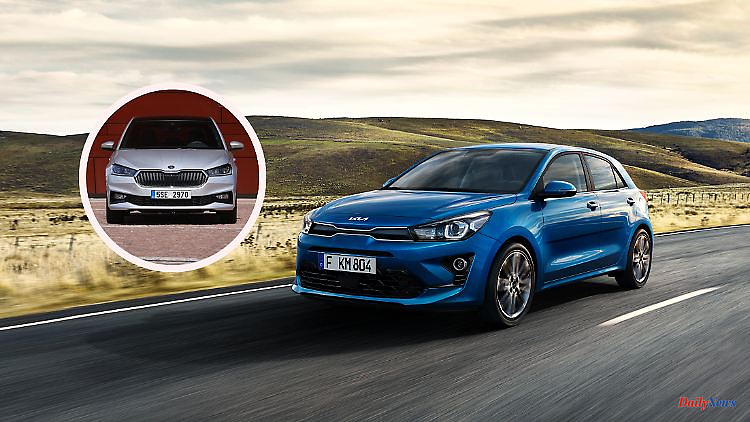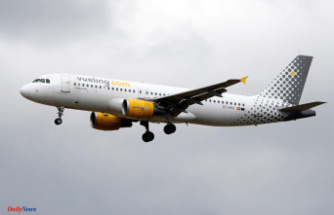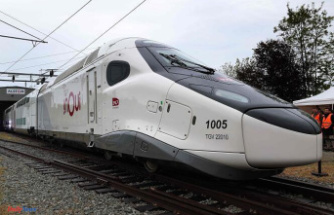Fully fledged new cars, which are suitable as the main car for a whole family, do not necessarily have to be prohibitively expensive. Using the example of the Kia Rio for just under and the Škoda Fabia for just over 20,000 euros, ntv.de is testing how much car people really need.
"Man does not live by bread alone", apparently already knew the prophet Moses, as can be read in the Old Testament of the Bible. This wisdom is still valid today and even for the automotive sector. For financial reasons, many motorists are at best able to afford a new car from the lower bread and butter class. Now the question to be derived from this thought is: can cars in this category be fun at all?
Spoiler alert: It doesn't get really emotional here, but joy can certainly arise. Because with the selected budget of plus or minus 20,000 euros, in the case of the Kia Rio and Škoda Fabia, you already get upscale variants. After all, the models are already available from 14,540 (Fabia) or 15,590 euros (Rio), but then with cutbacks in the drive. Cars have become expensive, less than 15,000 euros is not much more if you want to be on the road in terms of quality and technology. Just under 20,000 euros, on the other hand, already means more than minimal automobile mobility. The food for the soul, which differs from bread in the logic of Moses, can of course also be transferred to cars and this attempt must be dared here.
The willing buyer gets soul food if he spends exactly 20,440 euros for the Škoda Fabia. Because for this tariff he even gets the modern direct injection engine with 110 hp and doesn't have to struggle with the tough base (66 hp). The proof of the pudding is in the eating, so throw it in the Fabia. The Czech doesn't look really small and the interior design doesn't seem poor at all.
Tap the start button (by the way, the base would have to use a key at this point), and the robust one-liter three-cylinder comes to life. But at least you quickly notice that it is solidly insulated so that it doesn't get uncomfortably loud inside. It gets even finer once you're on the road with the four-door hatchback. Then you notice that the small-volume turbo is able to tackle powerfully. With the 1500 euro expensive automatic transmission (installed in the test car), the colleague Cityflitzer is a touch more comfortable - but also more expensive. The seven-stage double coupler needs a moment to sort itself out.
Short scene change. So quickly jumped into the older Kia Rio at the exact basic rate of 19,450 euros in the version discussed here. Its engine now follows the same technical pattern: there is also one liter of downsized displacement, which is divided into three pots. The turbocharger puts pressure on the mini engine so that it can gallop 100 horses instead of the 84 from the much more sluggish sucker of the bare base. But here the test car is shifted manually instead of automatically, which is now almost refreshing in a world (at least in the western world) of increasing automatic shares.
When it comes to the interior, the Rio is a bit more old school than the Fabia, but thanks to facelifts, the display part isn't neglected either. A central monitor with a touch-sensitive design ensures that commands are implemented quickly.
Only the instrument cluster still has mechanical displays, a relic, however, which one or the other customer may also be happy about in the age of the widespread TFT display. After all, clockwork can also delight. But back to the powertrain. It is already clear that the one-liter twin, which whirrs in the key just as typically as the Fabia unit, pulls quite a bit on the front tires of the Korean. These 100 hp candidates (this also applies to the Škoda) are not exactly underpowered, but they are not wild racers either (both around ten seconds to 100 km/h and 188 or the Skoda 205 km/h fast). But it is enough to quickly climb even steep inclines.
More important for practical handling, especially with the Rio, is the ease with which its shifter slips through the streets. Also applies to the clutch pedal. It makes sense that the customer can choose, because there are still many drivers who like to change the gear ratios themselves. Of course they can with the Fabia too.
So there is nothing wrong with the drive of the 20,000 euro candidate - but what about comfort, safety and technology? With a good amount of airbags, autonomous emergency braking system, Bluetooth hands-free system, electric windows, automatic climate control, parking beepers, heated seats, active lane departure warning system and cruise control, the Koreans are doing well. With the Czech, on the other hand, you have to pay money (from 330 euros) for the parking sensors, but LED headlights are again standard.
Point also for the Fabia: the smartphone integration is standard here and would make the integrated navigation system obsolete. The aluminum wheels are free at Kia, while Škoda calls for at least 550 euros here.
What is really amazing is the level of active security that is already offered for 20,000 euros. In particular, the autonomous brake assistant effectively prevents rear-end collisions. On the other hand, the lane departure warning system is rather controversial because it tends to countersteer in the slightest deviation from the middle of the lane. This can even bring instability into the vehicle if you don't grip the steering wheel firmly.
For a relatively moderate course, the Fabia has the (quite sensible) active cruise control: 280 euros. Then makes a total of 22,220 euros list - but then the car is really comfortable. Simply let the vehicle roll in heavy stop-and-go traffic - it brakes automatically if the vehicle in front does the same. Nevertheless, with so-called assisted driving, you always have to be ready to brake and be able to intervene in the driving situation.
With the Kia Rio you have to pay 200 euros more to enjoy this feature. First, it must be the automatic version in the "Spirit" equipment line (22,450 euros) - then the P5 technology package is required. It costs another 1350 euros, so it ends up being 22,450 euros. But then cross traffic warning and the keyless locking system on board, which in turn costs 390 euros extra for the Fabia.
When it comes to infotainment, the two small cars are also quite fit, although the Kia does not have a display that consists entirely of a display surface (available on the Fabia for an additional charge of 420 euros). Here you have to be content with a smaller information field between the speedometer scales - also in order. A head-up display (as discussed in the recently published Mazda 2 Hybrid practical test) is not available for either of the candidates discussed here.
But the Kia Rio and Škoda Fabia are pretty grown-up cars with a length of 4.07 and 4.11 meters respectively - that was compact class format not so long ago. In this respect, both front-wheel drive vehicles offer decent space, even in the second row. This answers the question of whether the two are suitable as full-fledged family cars: expressly yes.
More than 1100 liters of trunk volume give both about 1.2 ton small cars practical skills. Whereby the Škoda displays useful elements in a particularly quirky way. You notice that at the latest when you discover the ice scraper in the tank cap. In addition, the Czech surprises with idiosyncratic gimmicks such as an umbrella compartment in the door or the ticket holder in the windshield. A variable trunk floor with cargo elements and storage compartments rounds off the practical chapter of the Škoda.
Finally, it should be mentioned that the two petrol engines with an average WLTP consumption of 4.8 to 6.3 liters (depending on the tire size) are among the most economical in the country. In conclusion, it can be stated: Of course, there is basically bread and butter mobility for 20,000 euros, if you want to put it that way - at least that applies to the drive. But there are also some luxury features that the customer can then enjoy.
And something else that is important: Both candidates are really beyond any doubt in terms of quality and can even easily compete with the products of the relevant premium brands in this regard. If that isn't even the real luxury.












